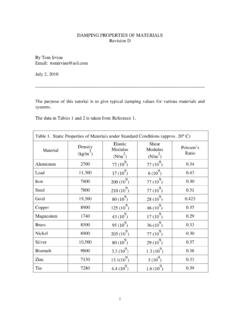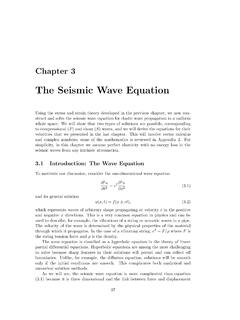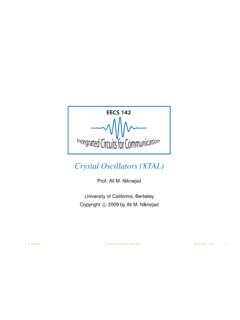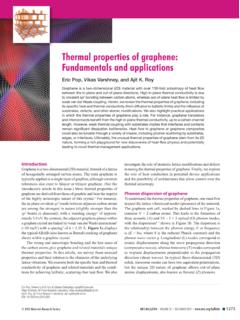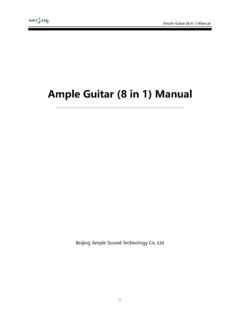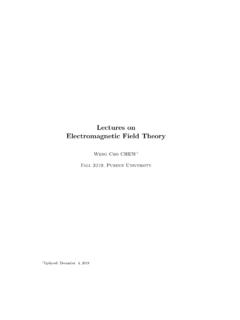Transcription of Part 3 REFLECTION AND TRANSMISSION OF ULTRASONIC …
1 Part 3 REFLECTION AND. TRANSMISSION OF. ULTRASONIC WAVES. Nearly all applications of ultrasonics involve the interaction of waves with boundaries. Nondestructive testing, medical imaging and sonar are ready examples of this. Even basic studies of material properties, usually involving the attenuation of waves, require in the final analysis accounting for boundary interactions. REFLECTION / TRANSMISSION - normal incidence The simplest situation of REFLECTION and TRANSMISSION occurs when waves are impinging normal to the surface. In Fig. , the case of a longitudinal wave incident on the interface between two media is shown.
2 This situation may be described mathematically in terms of three propagating waves Incident Wave REFLECTION 1 , c1. 2, c2. TRANSMISSION Figure REFLECTION and TRANSMISSION of an acoustic wave at normal incidence to a plane boundary. 3-1. ui = Ai sin ( k1 x t ) , ( ). ur = Ar sin [ ( k1 x + t )] , ( ). ut = At sin( k 2 x t ) . ( ). The amplitude of the reflected and transmitted waves may be found by noting that the displacements and stresses must be the same (continuous) at the interface. Thus, for x = 0, it is required that ui + ur = ut and i + r = t . ( ). This leads directly to the result Ar c 2 1 c1.
3 Rd = = 2 ( ). Ai 1 c1 + 2 c 2. and At 2 1 c1. Td = = . ( ). Ai 1 c1 + 2 c 2. This gives the ratio of the displacement amplitude. More commonly, the stress (or pressure). amplitudes are given. Thus, r c 1 c1. Rs = = 2 2 = Rd ( ). i 1 c1 + 2 c 2. and t 2 2 c2. Ts = = Td , ( ). i 1 c1 + 2 c 2. where R and T are known as the REFLECTION and TRANSMISSION coefficients. It is seen that these results are in terms of the respective acoustic impedances of the materials. 3-2. Illustration of the REFLECTION and TRANSMISSION at various interface combinations are worth considering.
4 For steel-water, we have s cs = 106 kg / m 2 s and w cw = 15 . 106 kg / m 2 s . From Eqs. and , one obtains R = and T = . The interpretation of this result is that the amplitude of the reflected stress wave is (or ) that of the incident amplitude. The negative sign indicates that the reflected wave is 180o out of phase with the incident wave. Thus, when the incident wave is compressive, the reflected wave is tensile and vice-versa. The transmitted pressure amplitude is but of the incident amplitude. This REFLECTION / TRANSMISSION situation is shown in Fig. For water- steel, by using the previous values for s cs,, w, and cw, we obtain from Eqs.
5 And R = and T = 1938 .. Thus, the reflected wave amplitude is nearly the same as the incident amplitude, where the transmitted (stress) amplitude is nearly twice the incident amplitude, as shown in Fig. a) steel water pi pt pr b) water steel pi pt pr Figure Sound pressure values in the case of REFLECTION from (a) a steel-water and (b) a water-steel interface at normal incidence. The preceding result may appear strange, as though conservation of energy were being violated. However, both wave amplitude and wave velocity determine the time rate of flow of energy (i. e., power) at the interface.
6 In terms of power, there should be a net balance. That is, 3-3. Pr + Pt = Pi ( ). should be satisfied. The power per unit area (i. e., intensity) will be given by I = v , where = C11 u / x and v = u / t . Using Eqs. to calculate Pi, Pr, Pt and substituting in the power balance expression shows it to be satisfied. Special cases: Suppose media 2 is vacuum, so that 2 c 2 = 0 . One obtains Rdfree = 1, Tdfree = 2 , Rsfree = 1, and Tsfree = 0. indicating a simple phase reversal of the incident wave. Suppose media 2 is infinitely rigid, so that 2 c 2 . Then from Eqs. through one obtains Rdclamped = 1, Tdclamped = 0 , Rsclamped = 1, and Tsclamped = 2.
7 There is thus no phase reversal of the incident displacement wave. The case of shear waves normally incident on a boundary may also be considered. However, a small subtlety arises. If the two media are bonded together, then conditions at the interface would be that v i + v r = v t , i + r = t , and expressions of the form Eqs. trough would be obtained, with all velocities merely being changed to shear wave velocities. However, the more common cases of a fluid-solid interface or of two solids separated by a thin film of lubricant would prevent TRANSMISSION of shear waves across the interface.
8 The case of waves normally incident on a layer sandwiched between two media is the next step of complexity and represents a situation frequently arising in ultrasonics. REFLECTION at and TRANSMISSION through an elastic layer exhibit strong frequency dependence associated with resonances in the layer. One of the simplest approach to describe this problem is applying the impedance-translation theorem to the layer [See for example, L. M. Brekhovskikh, Waves in Layered Media (Academic, New York, 1980) pp. 23-26]. The impedance-translation theorem says that the input impedance Zinput of a layer can be calculated from the loading impedance Zload presented by the medium behind the layer and the acoustic impedance Zo of the layer itself as follows: 3-4.
9 Zload i Zo tan( ko d ). Zinput = Zo . ( ). Zo i Zload tan( ko d ). Although this theorem is well known and widely used in several area, such as electrical engineering, it is very instructional to derive it from the boundary conditions prevailing at the two interfaces. Let us write the stress distribution in the layer in the following general form: ( x ) = A+ exp( i ko x ) + A exp( i ko x ), ( ). which is the sum of a forward and backward propagating plane wave. A+ and A- are the complex amplitudes of the two waves and we omitted the common exp(-i t ) term. The velocity distribution is given by / x 1.
10 V( x ) = = [ A+ exp( i ko x ) A exp( i ko x )] . ( ). i o Zo The input impedance of the layer is ( 0 ) A + A . Zinput = = Zo + , ( ). v ( 0) A+ A . where the ratio of the complex amplitudes A+ and A can be determined from the condition that ( d ) A ei ko d + A e i ko d Zload = = Zo + i k d . ( ). v(d ) A+ e o A e i ko d A+ Z e i ko d + Zo e i ko d = load i k d ( ). A Zload e o Zo ei ko d Substitution of ( ) into ( ) yields Zload cos( ko d ) i Zo sin( ko d ). Zinput = Zo ( ). Zo cos( ko d ) i Zload sin( ko d ). which is identical with the previously given form of ( ).
